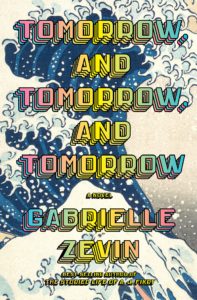 I love this book, and I can assure you that you do not have to be a gamer to enjoy this novel. My biggest video game accomplishment is being a mediocre Frogger player back in the day, and I honestly did not realize that the book was about video games before I started reading. The two main characters in this story are Sadie and Sam. They meet as young children in a hospital; Sam is playing a video game as he recovers from a car accident, and Sadie wanders into the game room while visiting her older sister in the hospital. The two bond over their affinity for playing video games, and they become best friends. Their friendship ends over a misunderstanding of sorts, and Sam and Sadie lose touch until they meet in an MBTA station in Harvard Square when they are both in college.
I love this book, and I can assure you that you do not have to be a gamer to enjoy this novel. My biggest video game accomplishment is being a mediocre Frogger player back in the day, and I honestly did not realize that the book was about video games before I started reading. The two main characters in this story are Sadie and Sam. They meet as young children in a hospital; Sam is playing a video game as he recovers from a car accident, and Sadie wanders into the game room while visiting her older sister in the hospital. The two bond over their affinity for playing video games, and they become best friends. Their friendship ends over a misunderstanding of sorts, and Sam and Sadie lose touch until they meet in an MBTA station in Harvard Square when they are both in college.
Sam is studying at MIT and Sadie is at MIT. Sadie gives Sam a copy of a game that she created for her Advanced Games seminar, and they soon begin to work on creating a video game together. Their first game is “Ichigo,” and it becomes a huge success. Sam’s roommate, Marx, is their producer, and the three of them put their hearts and souls into their new company, Unfair Games. The book’s greatest success is the friendships and the evolution of the relationships that the characters navigate, both together and separately.
There are so many layers to the story, as Sam, Sadie and Marx create more games with varying levels of success. The book incorporates issues such as disabilities, racism in the art world, abusive relationships, cultural appropriation, the feeling of isolation and “otherness” that is sometimes experienced by people who are multiracial, gender equality and same-sex marriage, etc. into the story, and the storytelling moves between persepctives and time. We meet the characters as new adults, and truly get to know them as we peek into their childhoods and see how their experiences and struggles led them on their journeys to adulthood.
The book is not perfect; it is long and at times it feels a tiny bit repetitive. Those are the only two negatives that I can think of. There are a lot of subplots and storylines, but the author does a fantastic job of bringing everything together in a way that feels authentic. The book reads as if the author is a video game designer, but as a reader, I again promise that you do not have to be a video game enthusiast to love this book. I rated this book five stars, and I highly recommend it. And if you haven’t read Gabrielle Zevin’s earlier books, especially The Storied Life of A.J. Fikry and Young Jane Young, you have some great reading ahead of you!


